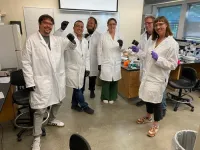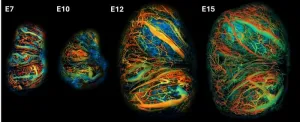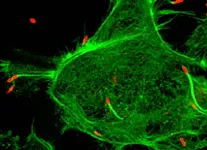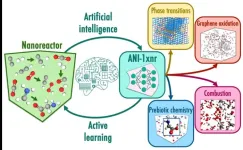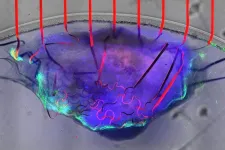(Press-News.org) Milan, Italy: Patients with breast cancer that has started to spread to the lymph nodes in the armpit can safely avoid extensive removal of the lymph nodes if their treatment is tailored to their response to cancer-killing therapies such as chemotherapy before surgery.
In a presentation to the 14th European Breast Cancer Conference today (Friday) in Milan, Annemiek Van Hemert, a doctor and PhD student in the Surgical Oncology Department of Antoni van Leeuwenhoek-Netherlands Cancer Institute (AVL-NKI) in Amsterdam (The Netherlands), said: “If we are able to predict the response based on the removal of only one lymph node, it means we can safely avoid extensive removal of the lymph nodes if no living tumour cells are left. This will avoid serious complications, such as painful swelling in the arm, known as lymphoedema.
“However, although clinicians use a number of staging techniques to predict the response, until now robust data on cancer outcomes have been lacking, especially in patients whose cancer has spread to more than three lymph nodes.”
Dr Van Hemert and colleagues, led by Professor Marie-Jeanne Vrancken Peeters at the AVL-NKI, carried out a study involving 218 patients between 2014 and 2021 to investigate cancer outcomes of the MARI protocol (“Marking Axillary lymph nodes with Radioactive Iodine seeds”). The protocol was developed at the AVL Hospital in 2014 and is now being used in several Dutch hospitals. Today’s presentation gives outcomes after four years for the rate of cancer recurrence in the axillary nodes, patients’ overall survival and disease-free survival.
“We focused on patients with more extensive axillary lymph node disease: the patients where we know there were cancer cells in more than three nodes. We used FDG-PET/CT scans to assess the extent of cancer spread to the lymph nodes,” said Dr Van Hemert [1].
“We marked the largest axillary lymph node with a radioactive iodine seed. After this, patients underwent primary systemic treatment: either chemotherapy or targeted therapies that find and attack cancer cells. Then surgery was performed. During the surgery, we only removed the marked lymph node, the MARI node, and examined it for any remaining living tumour cells.
“Whenever the MARI node showed there were no residual tumour cells, in other words a pathological complete response (pCR) to the primary systemic treatment, then we did not remove any additional lymph nodes. Patients who had residual disease in the MARI node had further lymph nodes removed: known as an axillary lymph node dissection. All patients received radiation treatment.”
The MARI procedure had a false negative rate of 7% which means that it missed living cancer cells in 7% of cases. After an average of 44 months (with a range of 26-62 months), the rate of cancer recurrence in the axillary nodes was 2.9% in the 103 patients who received radiation alone with no further lymph node removal – 47% of the study’s 218 patients.
“In addition, survival rates after 44 months in these patients were excellent,” said Dr Van Hemert. “The overall survival rate was 95%, and 89% of patients survived without a recurrence of invasive disease. This means that we can safely omit the extensive removal of axillary lymph nodes in patients who achieve a pCR in the MARI node after primary systemic treatment.”
The axillary recurrence rate in the 115 patients (53%) who required further lymph node removal was 3.5%, with an overall survival rate of 90% and a disease-free survival rate of 82%.
She said primary systemic treatment had improved greatly in recent years, and up to 70% of patients treated this way achieved a pCR, but surgeons were still removing all the axillary lymph nodes. “The pathologist would say: ‘Nice, you have removed 18 lymph nodes and none of them contained residual tumour cells’. So this raised the question: did we do the right thing for the patient by removing so many nodes with all the ensuing complications?
“We hope that other clinicians will think of implementing this de-escalation strategy so that more patients with breast cancer will benefit from what we have shown: surgical removal of axillary nodes can be safely omitted in around 80% of patients treated with primary systemic therapy.”
The researchers will be collecting further data on outcomes over a longer period. They have also started the DESCARTES trial [2] to investigate the safety of omitting radiation treatment in a selected group of patients with tumours smaller than two centimetres in diameter, no evidence of the cancer spreading to the lymph nodes and pCR after primary systemic treatment.
The co-chair of the 14th European Breast Cancer Conference is Dr Fiorita Poulakaki, Head of the Breast surgery Department at Athens Medical Centre Hospital, Greece, and Vice President Europa Donna, the European Breast Cancer Coalition, and she was not involved with this particular research project. She commented: “When we treat patients for breast cancer, it is important to ensure that treatment itself causes as little harm to the patients as possible. The results from this study suggest a way to help us avoid side effects that affect the quality of life and can sometimes cause considerable long-term distress to patients. Every day we cure patients, making sure they live long lives, but at the same time we should care also about survivorship issues. We look forward to further results from this trial.”
(ends)
Abstract no: 14, “Omission of axillary lymph node dissection in cN2-3 breast cancer patients with an excellent response on primary systemic treatment is safe: 4-year oncologic outcome of the MARI protocol”, Friday 22 March, oral abstract session, 09:30-11:00 hrs CET, Silver room. https://cm.eortc.org/cmPortal/Searchable/ebcc14/config/Normal/#!sessiondetails/0000107230_0
[1] FDG-PET: FDG is a radioactive sugar that is taken up by cancer cells and can be detected by a positron emission tomography (PET) scan. CT: computed tomography scan that uses x-rays.
[2] DESCARTES: De-Escalating RadioTherapy in breast cancer patients with pathologic complete rESponse to neoadjuvant systemic therapy. https://clinicaltrials.gov/study/NCT05416164
END
Breast cancer patients can safely avoid extensive removal of lymph nodes if they respond well to primary systemic treatment
2024-03-22
ELSE PRESS RELEASES FROM THIS DATE:
Replacing sugar with sweeteners can improve weight loss control over the long-term in adults in the overweight range, finds European randomised controlled trial
2024-03-21
*This is an early press release from the European Congress on Obesity (ECO 2024) Venice 12-15 May. Please credit the Congress if using this material*
New research being presented at this year’s European Congress on Obesity (ECO) in Venice, Italy (12-15 May), suggests that replacing sugar-sweetened food and drinks with low/no energy sweetened products can help weight control for at least one year after rapid weight loss in adults, without increasing the risk of type 2 diabetes or cardiovascular disease.
The findings of a year-long randomised controlled trial involving adults with overweight and obesity and children in the overweight range from Northern, Central and ...
Early registration opens for 2024 International Space Station Research and Development Conference in Boston
2024-03-21
BOSTON (MA), March 21, 2024 – This July, the 13th annual International Space Station Research and Development Conference (ISSRDC) returns to Boston, where leaders from the commercial sector, U.S. government agencies, and academic communities will assemble to highlight innovations and opportunities through our nation’s orbiting outpost. ISSRDC will take place July 30-August 1, 2024, at the Marriott Copley Place in Boston. Early registration is now open until May 24, 2024. Booking during early ...
Marine Biological Laboratory announces 2024 Logan Science Journalism Fellows
2024-03-21
WOODS HOLE, Mass. –Twelve accomplished science and health journalists have been awarded a highly competitive fellowship in the Logan Science Journalism Program at the Marine Biological Laboratory (MBL).
Now in its 37th year, the Logan Science Journalism Program provides journalists with immersive, hands-on research training, giving them invaluable insight into the practice of science as well as some of the major news stories of today. The program, which offers a Biomedical course and an Environmental course, will run May 13-23 in Woods Hole.
Biographies for the 2024 Logan Science Journalism Fellows are here. They are:
Biomedical Fellows
Pakinam Amer, Independent ...
Novel imaging platform allows researchers to study placental development in pregnant mice
2024-03-21
DURHAM, N.C. -- Physicians and biomedical engineers at Duke University have developed a method to visualize the growth of a placenta throughout a mouse’s pregnancy. By coupling an implantable window with ultrafast imaging tools, the approach provides the first opportunity to track placental development to better understand how the organ functions during pregnancy.
This new perspective gives researchers a precise way to examine how lifestyle factors like alcohol consumption and health complications like inflammation can affect the placenta and potentially lead to adverse pregnancy outcomes.
The research appears March 20 as the cover ...
AMS Science Preview: “Outdoor days,” lightning, air pollution
2024-03-21
The American Meteorological Society continuously publishes research on climate, weather, and water in its 12 journals. Many of these articles are available for early online access–they are peer-reviewed, but not yet in their final published form.
Below is a selection of articles published early online recently. To view full article text, members of the media can contact kpflaumer@ametsoc.org for press login credentials.
Observed Changes in Extreme Precipitation Associated with United States Tropical Cyclones
Journal of Climate
Rainfall ...
Illinois study: Systematic review of agricultural injuries can help inform safety measures
2024-03-21
URBANA, Ill. – Agricultural occupations are hazardous with one of the highest rates of workplace injuries and fatalities in the U.S. The manual and often strenuous nature of the work, combined with the use of machinery and exposure to environmental hazards create a challenging work environment. Understanding the nature and causes of injuries can help improve safety guidelines and policy measures. However, obtaining a comprehensive overview of injuries is hindered by the absence of a central reporting system. Two ...
New vaccine against a highly fatal tropical disease – and potential bioterror weapon – demonstrates efficacy in animal studies
2024-03-21
In a mouse study, UCLA researchers tested a vaccine against the bacterium that causes melioidosis and found it was highly protective against the disease, which is endemic in many tropical areas, causing approximately 165,000 cases with 89,000 fatalities around the world each year.
The bacterium, called Burkholderia pseudomallei, is spread through contact with contaminated soil and water through inhalation, ingestion or broken skin. It is so dangerous that it is categorized as a Tier 1 Select Agent of bioterrorism, and it can cause ...
Artificial intelligence helps explore chemistry frontiers
2024-03-21
The ability to simulate the behavior of systems at the atomic level represents a powerful tool for everything from drug design to materials discovery. A team led by Los Alamos National Laboratory researchers has developed machine learning interatomic potentials that predict molecular energies and forces acting on atoms, enabling simulations that save time and expense compared with existing computational methods.
“Machine learning potentials increasingly offer an effective alternative to computationally ...
UMass Amherst engineers create bioelectronic mesh capable of growing with cardiac tissues for comprehensive heart monitoring
2024-03-21
AMHERST, Mass. – A team of engineers led by the University of Massachusetts Amherst and including colleagues from the Massachusetts Institute of Technology (MIT) recently announced in the journal Nature Communications that they had successfully built a tissue-like bioelectronic mesh system integrated with an array of atom-thin graphene sensors that can simultaneously measure both the electrical signal and the physical movement of cells in lab-grown human cardiac tissue. In a research first, this tissue-like mesh can grow along with the cardiac cells, ...
Researchers take major step toward developing next-generation solar cells
2024-03-21
The solar energy world is ready for a revolution. Scientists are racing to develop a new type of solar cell using materials that can convert electricity more efficiently than today’s panels.
In a new paper published February 26 in the journal Nature Energy, a University of Colorado Boulder researcher and his international collaborators unveiled an innovative method to manufacture the new solar cells, known as perovskite cells, an achievement critical for the commercialization of what ...


